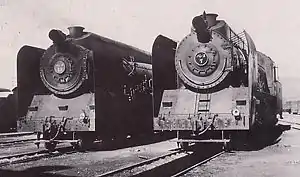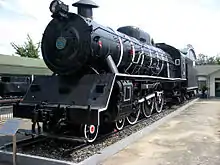Sentetsu Pashiko-class locomotive
The Pashiko class (パシコ) locomotives were a group of steam tender locomotives of the Chosen Government Railway (Sentetsu) with 4-6-2 wheel arrangement. The "Pashi" name came from the American naming system for steam locomotives, under which locomotives with 4-6-2 wheel arrangement were called "Pacific".
| Chosen Government Railway Pashiko class (パシコ) Korean National Railroad Pasi5 class (바시5) Korean State Railway Pasio class (바시오) | |||||||||||||||||||||||||||||||||||||||||||||||||||
|---|---|---|---|---|---|---|---|---|---|---|---|---|---|---|---|---|---|---|---|---|---|---|---|---|---|---|---|---|---|---|---|---|---|---|---|---|---|---|---|---|---|---|---|---|---|---|---|---|---|---|---|
 Sentetsu Pashiko class locomotives パシコ7 and パシコ13 | |||||||||||||||||||||||||||||||||||||||||||||||||||
| |||||||||||||||||||||||||||||||||||||||||||||||||||
| |||||||||||||||||||||||||||||||||||||||||||||||||||
| |||||||||||||||||||||||||||||||||||||||||||||||||||
| |||||||||||||||||||||||||||||||||||||||||||||||||||
In all, Sentetsu owned 144 locomotives of all Pashi classes, of which 141 survived the war; of these, 73 went to the Korean National Railroad in South Korea and 68 to the Korean State Railway in North Korea.[1]
Description

Sentetsu designed the Pashiko class as a successor to the Pashishi class, with the first example, パシコ1, being delivered from Sentetsu's Gyeongseong Works in October 1939, and the second following a month later. They were not only the largest of all Sentetsu passenger locomotives in size, but at 159.8 t (157.3 long tons) they were the heaviest of all Sentetsu locomotives of any type, and with a maximum speed of 110 km/h (68 mph) they were the fastest as well.[2]
Like the Matei class, which was the largest of all Sentetsu's freight locomotives, the Pashiko class had a firegrate area of 6.2 m2 (67 sq ft), and like the Pashishi and its related classes, it was designed to use lignite abundant in Korea, which is less efficient than anthracite and thus requires a large heating area, and featured a combustion chamber firebox and a conical boiler. Unlike the other Pashi classes, which had drivers of 1,750 mm (69 in) diameter, the Pashiko had even larger drivers of 1,850 mm (73 in).[2]
| Year | Running Number | Builder | Total |
|---|---|---|---|
| Oct 1939 | パシコ1 | Gyeongseong | 1 |
| Nov 1939 | パシコ2 | Gyeongseong | 2 |
| 1940 | パシコ3–パシシ12 | Kawasaki | 10 |
| 1941 | パシコ13–パシシ22 | Kawasaki | 10 |
| 1942 | パシコ23–パシシ35 | Kawasaki | 13 |
| 1943 | パシコ36–パシシ40 | Kawasaki | 5 |
| 1944 | パシコ41–パシシ42 | Kawasaki | 2 |
| Builder totals | Gyeongseong | 2 | |
| Kawasaki | 40 | ||
| Total | 42 | ||
Postwar
After the Liberation and partition of Korea, they were divided between North and South, but the specifics of which engine went where are unclear.
Korean National Railroad 파시5 (Pasi5) class
At least eighteen Pashiko class engines went south to the Korean National Railroad, where they became 파시5 (Pasi5) class, and they were widely used on passenger trains until at least 1967.[3] 파시5-5 was partially streamlined and given a special livery of black with white and red trim in the mid-1950s by the US Army Transportation Corps railway crews.[4]
| KNR number | Sentetsu number | Builder | Year | Notes |
|---|---|---|---|---|
| 파시5-1 | パシコ1 | Gyeongseong | 1939 | |
| 파시5-2 | パシコ2 | Gyeongseong | 1939 | |
| 파시5-3 | パシコ3 | Kawasaki | 1940 | |
| 파시5-4 | パシコ4 | Kawasaki | 1940 | |
| 파시5-5 | パシコ5 | Kawasaki | 1940 | Semi-streamlined by USATC crews after the Korean War. |
| 파시5-11 | パシコ11 | Kawasaki | 1940 | |
| 파시5-12 | パシコ12 | Kawasaki | 1940 | Derelict by 1953. |
| 파시5-16 | パシコ16 | Kawasaki | 1941 | |
| 파시5-18 | パシコ18 | Kawasaki | 1941 | |
| 파시5-19 | パシコ19 | Kawasaki | 1941 | |
| 파시5-20 | パシコ20 | Kawasaki | 1941 | |
| 파시5-21 | パシコ21 | Kawasaki | 1941 | |
| 파시5-23 | パシコ23 | Kawasaki | 1942 | Works number 2649. Preserved at the Korean Railway Museum. |
| 파시5-24 | パシコ24 | Kawasaki | 1942 | |
| 파시5-26 | パシコ26 | Kawasaki | 1942 | |
| 파시5-30 | パシコ30 | Kawasaki | 1942 | |
| 파시5-31 | パシコ31 | Kawasaki | 1942 | |
| 파시5-37 | パシコ37 | Kawasaki | 1943 | Still in service in 1968. |
| 파시5-38 | パシコ38 | Kawasaki | 1943 |
Korean State Railway 바시오 (Pasio) class
The locomotives taken over by the Korean State Railway were initially designated 바시오 (Pasio) class. The total number, their service lives and subsequent fates are unknown, but they were probably retired by the end of the 1960s.
References
- "North and South Korea Steam Locomotives". 20 April 2004. Archived from the original on 20 April 2004.CS1 maint: bot: original URL status unknown (link)
- Byeon, Seong-u (1999). 한국철도차량 100년사 [Korean Railways Rolling Stock Centennial] (in Korean). Seoul: Korea Rolling Stock Technical Corp.
- "Korean R Gaddie photos". donsdepot.donrossgroup.net.
- "Korean National RR Pacee-5 4-6-2". donsdepot.donrossgroup.net.